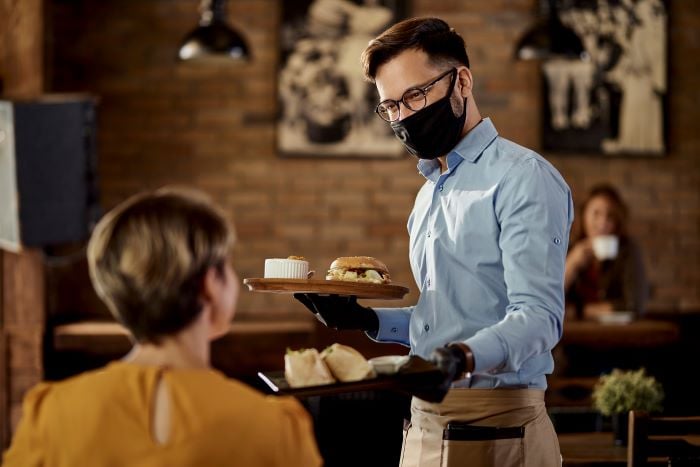
For many restaurant owners, Covid-19-related restrictions have been an existential crisis. Now, with restrictions slowly lifting for restaurants across the country, many are looking for ways to increase their capacity while still adhering to Covid-19 requirements.
Many restaurants are installing plexiglass shields between tables to increase capacity indoors, while others are painstakingly rearranging tables, trying to squeeze in as much seating as possible while still allowing for the required social distancing. Many restaurants are adding outdoor seating areas, often occupying space normally reserved for parking.
These efforts speak to the creative resiliency of restaurant owners in the face of unprecedented challenges. However, such approaches can carry significant risks if undertaken without fire safety regulations in mind.
Fire Safety Considerations for Indoor Dining Areas
Don't Block Those Fire Exits
It is important to remember that all the same fire safety requirements in place before Covid-19 still apply. If you have or are considering rearranging the seating in your dining area, make sure that none of the tables are blocking any part of the path of egress.
Keep Up with Your Inspections
Do not neglect the required inspections of your kitchen hood suppression systems. According to National Fire Protection Association (NFPA) code, commercial kitchen fire suppression systems must be inspected every six months. So, if you had not had yours inspected since before the pandemic started, your system is now out of compliance. Even if you were closed for some time or are not using them as much as before the pandemic, they still must be compliant with code and properly maintained to ensure they will function in the event of a fire.
Fire Safety Considerations for Outdoor Dining Areas
Many restaurants have added outdoor seating areas to extend their capacity during the pandemic. Recently, the NFPA published a fact sheet to help restaurants understand the safety considerations involved in using tents for this purpose. The fact sheet addresses issues such as the proper location of your tent, the flammability of tent fabric, and how to ensure proper egress.
Figure Out How Many Exits You Need
The number of exits needed to provide adequate egress depends on your tent's size, which determines its occupancy (the maximum number of people it can hold at any one time). Your local authority having jurisdiction (AHJ) can help you determine the correct occupancy for whatever tent you choose. However, you should expect that number to be further reduced by Covid-19 social distancing requirements.
Local requirements may vary, but a couple of other elements your tented dining area should have, whether required or not, are signs that mark all exits and emergency lighting. Once you get your tables and chairs into the space, you need to make sure there is a clear egress path and that none of the exits are blocked.
Ensure Emergency Vehicle Access
Make sure your tent is not blocking any areas previously reserved for emergency vehicle access. Likewise, if your tent reduces available parking, it is important to ensure patrons do not inadvertently park in these areas as well. Keep them clear at all times.
Use Portable Heaters Safely and in Accordance to Local Codes
We recommend first and foremost that restaurant owners considering using a tent with heaters of any kind consult with their local AHJ. On the local level, the rules can differ significantly as municipalities across the country have had to respond quickly during the pandemic to ensure that local codes cover a wider variety of temporary structures and heating appliances used in them.
Secondly, every restaurant using a portable heating appliance to extend their capacity should review the outdoor heater safety fact sheet recently published by the National Fire Protection Association (NFPA) to help people understand how to use portable outdoor heating appliances safely.
In addition to the requirements provided in the fact sheet, other important considerations include:
Proper Ventilation
Using heaters in tents introduces the risk of carbon monoxide poisoning if not properly vented. While tents should be made of fire retardant materials, care must still be taken to ensure all heaters are placed at a sufficient distance from the tent's sidewalls to prevent igniting the fabric. This information may be in the manufacturer's instructions for your heating appliance. But to be safe, you should contact your AHJ to ensure you are following all local requirements.
Proper Handling and Storage of Propane Tanks
Propane appliances are not the only way to heat an outdoor area, but they are one of the most common due to their portability and relatively low cost to operate. However, propane can also be very dangerous. A single 20-pound propane cylinder -- the size that most backyard gas grills use -- contains the explosive power of 170 sticks of dynamite. There is a lot of power contained in that cylinder, which is why it is critical that your tanks are properly stored and that every staff person knows how to handle them safely.
Ensure all restaurant staff also knows how to operate any portable heating appliance properly and turn them off when the area is no longer occupied.
Koorsen Can Help You Keep Your Patrons Safe
While local codes may still be evolving around the various approaches restaurants are using to extend their capacity, the same restaurant fire safety regulations that were in place before the pandemic remains in place. The fact sheets we have linked to in this article mention many NFPA requirements that must be met.
If you have questions on how to comply with these requirements or need to get caught up on your kitchen fire suppression system inspections, contact Koorsen today. We can help you ensure compliance with all the rules and regulations that apply to your business and give you some much-needed peace of mind during the remaining duration of this pandemic.

